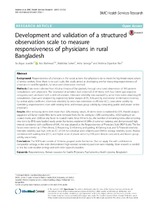| dc.description.abstract | BACKGROUND: Responsiveness of physicians is the social actions that physicians do to meet the legitimate expectations
of service seekers. Since there is no such scale, this study aimed at developing one for measuring responsiveness of
physicians in rural Bangladesh, by structured observation method.
METHODS: Data were collected from Khulna division of Bangladesh, through structured observation of 393 patientconsultations
with physicians. The structured observation tool consisted of 64 items, with four Likert type response
categories, each anchored with a defined scenario. Inter-rater reliability was assessed by same three raters observing 30
consultations. Data were analyzed by exploratory factor analysis (EFA), followed by assessment of internal consistency
by ordinal alpha coefficient, inter-rater reliability by intra-class correlation coefficient (ICC), concurrent validity by
correlating responsiveness score with waiting time, and known group validity by comparing public and private sector
physicians.
RESULTS: After removing items with more than 50% missing values, 45 items were considered for EFA. Parallel analysis
suggested a 5-factor model. Nine items were removed from the list owing to < 0.50 communality, <0.32 loading in unrotated
matrix, and <0.30 on any factor in rotated matrix. Since 34 items (i.e., the number of remaining items after removing
nine items by EFA) were loaded neatly under five factors, explained 61.38% of common variance, and demonstrated high
internal consistency with coefficient of 0.91, this was adopted as the Responsiveness of Physicians Scale (ROP-Scale). The five
factors were named as 1) Friendliness, 2) Respecting, 3) Informing and guiding, 4) Gaining trust, and 5) Financial sensitivity.
Inter-rater reliability was high, with an ICC of 0.64 for individual rater’s reliability and 0.84 for average reliability scores. Positive
correlation with waiting time (0.51), and higher score of private sector by 0.18 point denote concurrent, and known group
validity, respectively.
CONCLUSIONS: The ROP-Scale consists of 34 items grouped under five factors. One can apply this with confidence in
comparable settings, as this scale demonstrated high internal consistency and inter-rater reliability. More research is needed
to test this scale in other settings and with other types of providers. | en_US |
| dc.rights | © The Author(s). 2017 Open Access This article is distributed under the terms of the Creative Commons Attribution 4.0
International License (http://creativecommons.org/licenses/by/4.0/), which permits unrestricted use, distribution, and
reproduction in any medium, provided you give appropriate credit to the original author(s) and the source, provide a link to
the Creative Commons license, and indicate if changes were made. The Creative Commons Public Domain Dedication waiver
(http://creativecommons.org/publicdomain/zero/1.0/) applies to the data made available in this article, unless otherwise stated. | |

